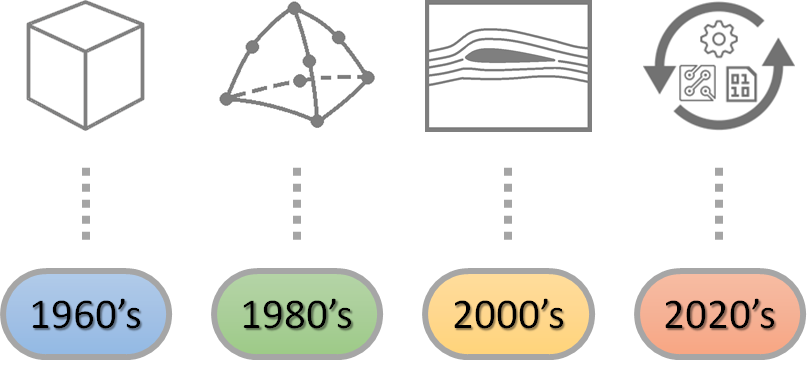(This History of CAD/CAE Technology Timeline is the second blog in a 2-part series. Here is part 1.)
Part 2: Technology Platforms
As we saw in the previous article, the Computer Aided Design/Engineering (CAD/CAE) industry has evolved from several independent one-dimensional (both figuratively and literally) computer programs to a series of interconnected design optimization platforms.
Of course you are probably familiar with your CAD, FEA, or CFD vendors' capabilities, but what about the rest of the industry? Are you aware of the history of the technology? Was it acquired or developed? A historical account can offer insight into where we are in the CAD/CAE landscape, and perhaps more importantly... where we are headed.
Interactive Data Viz
Once again, I decided to use the popular data visualization software, Tableau, to map this History of CAD/CAE Technology Timeline. In this map, however, I have color coded each path by the underlying technology. The grey horizontal lines separate the parent companies. For large companies, the parent company (most recognizable name) is in the middle. Scroll below, and use your mouse to hover over the nodes and learn more about each milestone in the amazingly dynamic industry of CAD/CAE.
A description of the different types of Technologies is listed below:
Math - Focus on Mathematical computation, Multi-variable graphing, and related functionality.
System - Platform/language for mapping out systems prior to detailed design.
PLM - Project Lifecycle Management software is used to manage design/engineering data as it matures through the product development process (i.e. from Concept to Obsolescence).
Render - Photo realistic image creation software.
Surfacing - Surface-based CAD modeling, most often used in Industrial and Conceptual Design.
AEC/BIM - Architecture, Engineering, Construction and Building Information Modeling.
EDA - Electronic Design Automation (ECAD) software is 2D/3D software used to design Electronic systems such as Circuit Board Assemblies and Integrated Circuits.
CAD - Computer Aided Design Software is used to create 3D geometry and design hardware product assemblies. In contrast to surfacing, CAD is generally regarded as "Solid Modeling".
Kinematics - Also known as Rigid Body Dynamics, this software is used to design/analyze vast array of moving machinery and mechanisms.
FEA - Finite Element Analysis is mainly used to simulate solid mechanics such as Static and Dynamic structural analyses and conductive heat transfer thermal analysis.
Fatigue - Used in conjunction with FEA to simulate cyclical loading such as a durability analysis to predict a designs ultimate lifespan.
CFD - Computational Fluid Dynamics software is used to simulate fluid flow (most often air & water) to better design the products that operate in/around those fluids; also used with conjugate heat transfer.
Acoustics - Simulation and visualization of acoustics and vibration to increase sound quality and reduce unwanted noise.
Emag - Simulation of electro-magnetic fields for Antennas, Electronics, Radars, Microwaves, etc.
Multiphysics - General description for a multi-purpose software suite that offers simulation capability across a range of multiple physics (i.e. structural, fluid, thermal, acoustic, etc.).
Optimization - Software which automatically creates an optimal shape based on user-provided inputs and constraints.
CAM - Computer Aided Manufacturing covers a wide range of software aimed at automating (or optimizing) manufacturing processes. The most popular subset of CAM is CNC - Computer Numerical Control software for machining.
Process - Manufacturing Process Management software is used to design and optimize manufacturing processes across an entire factory.
Various - Describes companies who are/were not in the CAD/CAE business before they acquired a CAD/CAE company.
Data Analytics - Management, Analysis, Visualization, general post processing of large data sets.
Data Viz Filtering: You can highlight a specific technology by clicking on it in the legend. You may also view just that particular technology by clicking on it and selecting "Keep Only". To Undo/Redo a filter, or to revert back to the original data set, click the corresponding buttons at the bottom of the data viz. View it in Full Screen Mode for the best graphics... Enjoy!
Credit
The data presented here is a mix of independent research and crowd sourcing. A big thank you goes out to the people on Linkedin who commented, shared, and connected with each other via the original Linkedin post. In addition, credit must go to David E. Weisberg who wrote an incredibly detailed book on the CAD industry called The Engineering Design Revolution, to Sebastian Fixson from Babson College who facilitated this research as well as Olivier Catherin of Actinvision who offered some much needed guidance with the data preprocessing.
This map is a permanent work in process as the industry continues to grow (through startups and new technologies) and consolidate (through mergers and acquisitions). Therefore, if you see any inaccuracies, or want to notify us of an update, please drop us a line through the button below.
The story will continue to evolve, and this graphic will be kept up-to-date. To get notified when the next update occurs, sign up for our newsletter below.



